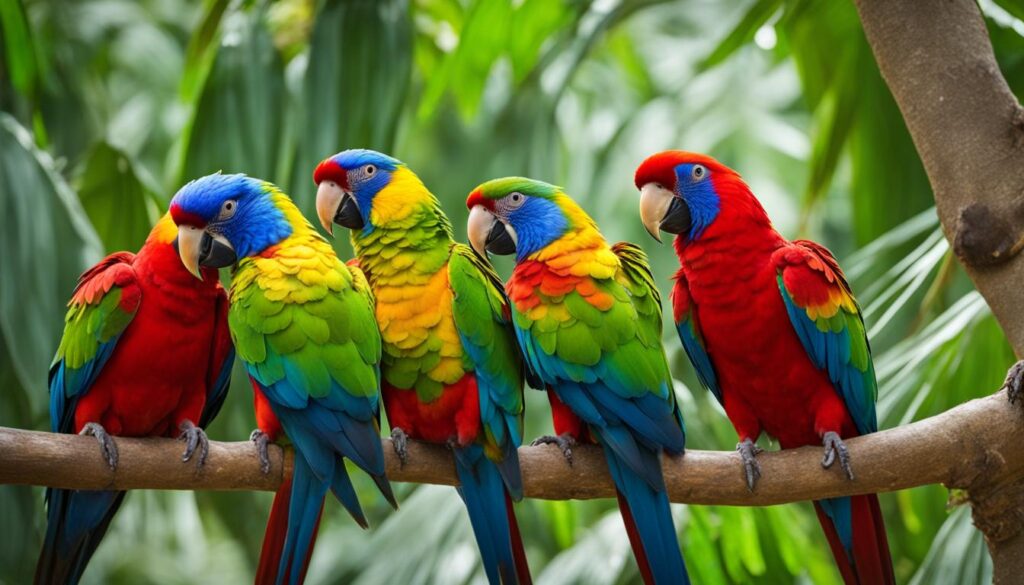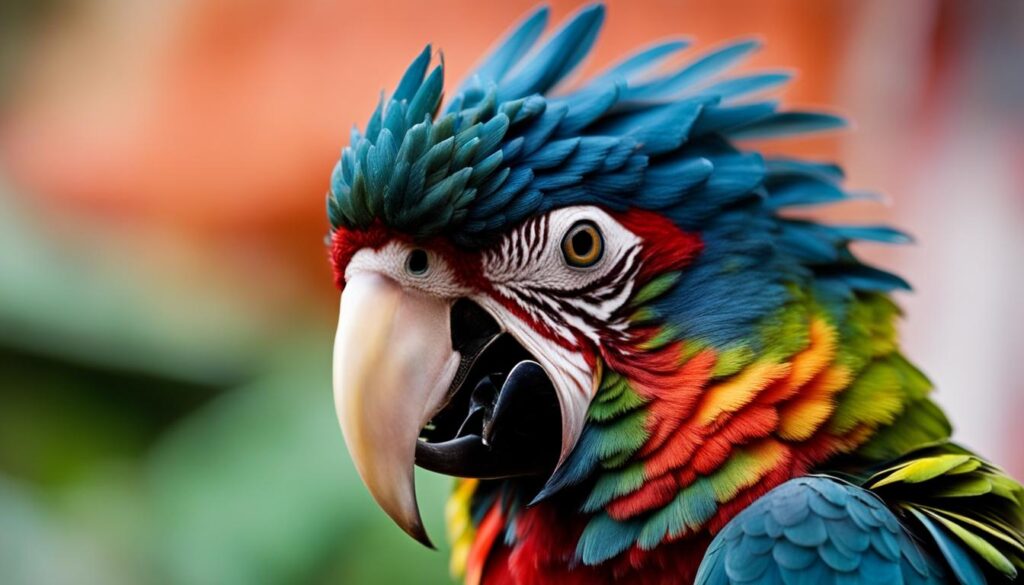The Social Life of Parrots: Understanding Their Behavior and Communication
Welcome to our guide on the social behavior and communication of parrots. Parrots are fascinating creatures known for their intelligence and captivating personalities. However, their complex behavior can often be misunderstood, leading to common problem behaviors such as screaming, biting, and difficulty bonding. In this article, we will explore the natural instincts and behaviors of parrots, providing insights from experts and real-life experiences studying wild parrot behavior. By understanding their behavior and communication, we can develop strategies to modify and interpret parrot behavior effectively.
Key Takeaways:
- Parrots exhibit complex behavior, and understanding their instincts is crucial for addressing problem behaviors.
- Positive reinforcement and a deeper understanding of parrot behavior are essential for managing challenges.
- Parrots communicate through vocalizations and nonverbal cues, and understanding their meaning promotes effective interaction.
- Social bonding is important for parrots, and auditory connections play a significant role in their relationships.
- Addressing common problem behaviors like screaming, biting, and aggression requires patience, recognition, and proper training techniques.
The Importance of Understanding Parrot Behavior
Parrot behavior can often be a source of frustration for owners and may even lead them to consider giving up their beloved pets. Undesirable behaviors such as screaming, biting, and aggression are rooted in the natural instincts of parrots. It is crucial to understand the distinction between instinctual behavior and learned behavior, as well as dispel common myths like height dominance.
In order to effectively address these problem behaviors, it is essential to employ positive reinforcement techniques and develop a deeper understanding of their behavior. By recognizing and respecting their natural instincts, we can provide appropriate outlets for their energy and redirect their behavior in a positive manner.
“Understanding parrot behavior is the key to unlocking a harmonious relationship with these intelligent creatures. Misunderstanding their instincts and anthropomorphizing their actions can lead to frustration and miscommunication.”
It is important to remember that parrots are not human, and projecting human emotions onto them can hinder effective communication and training. By using positive reinforcement methods, such as rewards and praise, we can incentivize desirable behaviors and discourage problem behaviors without resorting to punishment or harsh training techniques.
Acknowledging the unique characteristics and instincts of parrots allows us to address their needs and provide them with a enriched environment that promotes their well-being. By understanding parrot behavior, we can build a strong foundation for a fulfilling and rewarding relationship with our feathered companions.
The difference between instinctual behavior and learned behavior
Parrot behavior can be categorized into two main types: instinctual behavior and learned behavior.
- Instinctual behavior: One of the most important aspects of understanding parrot behavior is recognizing that many of their actions are rooted in instinct. These instincts developed over millions of years to help parrots survive in their natural environments. For example, parrots are naturally inclined to vocalize loudly as a form of communication and to establish their presence within a flock.
- Learned behavior: Parrots also have the ability to learn and adapt their behavior based on their environment and experiences. This means that some of their actions may be a result of learned behavior rather than instinct. For example, a parrot may learn to scream for attention if they have been inadvertently reinforced for that behavior in the past.
Dispelling myths about parrot behavior
There are several myths and misconceptions surrounding parrot behavior that can lead to misunderstandings and ineffective training:
- Height dominance: Contrary to popular belief, parrots do not exhibit dominance based on height. This belief often stems from anthropomorphism, which is the attribution of human characteristics to non-human entities. Parrot behavior is not driven by a desire for social dominance but rather by natural instincts and learned behaviors.
- Anthropomorphism: Anthropomorphizing parrot behavior can lead to misunderstandings and ineffective training. While parrots are intelligent creatures, they do not think or behave like humans. It is important to approach their behavior with an understanding of their unique instincts and needs.
By gaining a deeper understanding of parrot behavior and avoiding the pitfalls of anthropomorphism, we can effectively address problem behaviors and foster a positive relationship with our parrots. Through positive reinforcement and a focus on their natural instincts, we can create an environment where our feathered friends can thrive.
The Role of Communication in Parrot Behavior
Parrots are highly social creatures that rely on communication to interact with their environment and establish social bonds. Communication plays a crucial role in their behavior, allowing them to convey their needs, emotions, and intentions.
Vocalization: One of the key forms of parrot communication is vocalization. In the wild, parrots use specific vocalizations to claim territory, communicate with their community, and engage in play behavior. These vocalizations can vary in pitch, tone, and rhythm, each carrying a unique message. By understanding the meaning behind different vocalizations, we can gain valuable insights into their social interactions and emotional states.
Nonverbal Cues: In addition to vocalizations, parrots also communicate through nonverbal cues. Body language, feather position, and eye contact are all important nonverbal cues that convey messages in their social interactions. For example, an upright posture and fully extended feathers may indicate curiosity or attentiveness, while fluffed feathers and downcast eyes can signify relaxation or contentment. By being attentive to these nonverbal cues, we can better understand our parrot’s needs and emotions.
Effective communication is crucial for bonding and building a strong relationship with your parrot. By actively listening to their vocalizations, observing their body language, and responding appropriately, we can establish trust and ensure a harmonious bond.
“Communication is the key to understanding and connecting with our feathered companions. By learning to interpret their vocalizations and nonverbal cues, we can bridge the gap between human and parrot, creating a meaningful and fulfilling relationship.” – Dr. Jane Thompson, Avian Behavior Specialist
As parrot owners, it is our responsibility to engage in effective communication with our feathered friends. By doing so, we can create a nurturing and enriching environment that supports their social interaction and emotional well-being.

The Role of Vocalization in Parrot Communication
| Vocalization Types | Meaning |
|---|---|
| Contact Calls | Used to maintain social connection within the flock |
| Alarm Calls | Warn of potential threats or dangers |
| Mating Calls | Used during courtship and breeding season |
| Play Calls | Express joy and engage in social interaction |
| Aggression Calls | Indicate territorial disputes or dominance |
The Influence of Social Bonding on Parrot Behavior
Parrots are highly social creatures that form strong bonds with their flock members. This social bonding extends to their interactions with humans in captivity. Understanding the importance of social bonding and providing opportunities for social interaction is vital for the emotional well-being of parrots.
Parrots rely on auditory connections, such as contact calls, to maintain their social bonds and communicate with their flock members. These auditory connections serve as a means of identification and signal the presence of their companions. By responding to and reciprocating these vocalizations, parrots strengthen their social bonds.
“Social bonding is crucial for parrots’ overall happiness and behavior. It allows them to feel a sense of belonging and security, promoting positive mental well-being.”
Building a strong bond with your parrot is essential for their overall happiness and behavior. Interacting with them through play, training exercises, and providing mental stimulation helps foster a sense of connection. Socializing your parrot with other birds or trusted human companions also contributes to their social and emotional development.
Benefits of Social Bonding:
- Enhances emotional well-being.
- Reduces stress and anxiety.
- Promotes positive behavior.
- Strengthens the human-parrot bond.
Creating opportunities for social bonding:
- Engage in interactive playtime.
- Provide mental stimulation through puzzles and toys.
- Encourage social interactions with other parrots or trusted humans.
- Understand and respond to their auditory cues and vocalizations.
By prioritizing social bonding and understanding the importance of auditory connections, parrot owners can create a nurturing and enriching environment for their feathered companions.

Addressing Common Problem Behaviors in Parrots
Problem behaviors like screaming, biting, and aggression can be common in parrots. As responsible parrot owners, it is important for us to address these behaviors using positive reinforcement and understanding the underlying causes.
Screaming is a natural behavior in parrots, a way for them to communicate with their flock and express their needs. However, it can also become a learned behavior if it is reinforced with attention. Parrots quickly learn that screaming will capture their owner’s attention, leading to a cycle of attention-seeking behavior. By recognizing the signs of screaming and implementing effective training techniques, we can manage and modify this behavior.
Biting is not a natural behavior for parrots, but it can occur as a result of fear or self-defense. Understanding the triggers that lead to biting and providing a safe and secure environment can help prevent biting incidents. Positive reinforcement training can also help reshape a parrot’s response to fearful situations, reducing the likelihood of biting.
Aggression in parrots can be a complex issue and may stem from a variety of factors, such as fear, territoriality, or hormonal changes. Identifying the underlying cause of aggression is key to addressing the problem behavior. Consulting with an avian behaviorist or veterinarian experienced in working with parrots can provide valuable insights and guidance for managing and modifying aggressive behavior.
Remember, addressing problem behaviors in parrots requires patience, consistency, and a deep understanding of their needs and instincts. With positive reinforcement training and a compassionate approach, we can help our parrots overcome these challenges and create a harmonious relationship.
Here are some key strategies for addressing problem behaviors in parrots:
- Establish a consistent routine and provide a stimulating environment.
- Recognize and redirect attention-seeking behaviors, such as screaming.
- Implement positive reinforcement training techniques to encourage desired behaviors.
- Use desensitization and counter-conditioning methods to address fear-related behaviors.
- Consult with a professional to address aggressive behaviors and create a behavior modification plan.
By applying these strategies and investing time and effort in understanding our parrot’s behavior, we can effectively address problem behaviors and foster a positive and enriching relationship with our feathered companions.

Tips for Managing Screaming:
- Consistently reward quiet behavior and redirect attention away from screaming.
- Identify the triggers that lead to screaming and address them proactively.
- Provide mental and physical stimulation to keep your parrot engaged.
- Consider using white noise or calming music to reduce environmental stimuli that may trigger screaming.
- Consult with an avian behaviorist for personalized guidance.
By implementing these strategies and seeking professional guidance when needed, we can effectively manage and modify problem behaviors in our parrots, resulting in a happier and healthier bond between us and our feathered friends.
| Problem Behaviors | Causes | Management and Modification |
|---|---|---|
| Screaming | Natural behavior, attention-seeking | Consistent training, redirection, positive reinforcement |
| Biting | Fear, self-defense | Identify triggers, create a safe environment, positive reinforcement training |
| Aggression | Fear, territoriality, hormonal changes | Identify underlying cause, consult with avian behaviorist, behavior modification plan |
Conclusion
Understanding parrot behavior and communication is essential for the well-being of these fascinating birds and the development of a strong bond between humans and parrots. By acknowledging their innate instincts, effectively communicating with them, and fostering social bonding, parrot owners can address problem behaviors and cultivate a harmonious relationship with their feathered companions.
Patience is key when dealing with parrot behavior. Positive reinforcement techniques, such as rewards and praise, can be used to encourage desired behaviors and discourage unwanted ones. By paying attention to their needs and providing a stimulating environment, we can meet their social and cognitive requirements, promoting a fulfilling and happy life for them.
Building a strong foundation of trust and understanding with our parrots requires active communication. Parrots use both vocalizations and nonverbal cues to express themselves, and it is crucial for us to decipher their messages. By familiarizing ourselves with their vocalizations, body language, and other nonverbal cues, we can better interpret their emotions and intentions.
Social bonding plays a vital role in the well-being of parrots. In the wild, parrots form strong social bonds within their flock, and in captivity, they seek social connections with humans or other birds. By providing opportunities for social interaction, such as regular playtime or introduction to compatible parrot companions, we can help satisfy their social needs and prevent behavioral problems.
In conclusion, a deeper understanding of parrot behavior, effective communication, and the promotion of social bonding are key to addressing problem behaviors and building a strong relationship with these intelligent creatures. With patience, positive reinforcement, and a commitment to meeting their needs, we can create an enriching and fulfilling life for our beloved parrots.
FAQ
What are some common problem behaviors in parrots?
Common problem behaviors in parrots include screaming, biting, and aggression. These behaviors can be rooted in their natural instincts and require understanding and positive reinforcement to address effectively.
How can I address problem behaviors in my parrot?
Addressing problem behaviors in parrots involves using positive reinforcement and understanding the underlying causes. By recognizing signs of these behaviors and implementing effective training techniques, parrot owners can manage and modify these behaviors.
How do parrots communicate?
Parrots communicate through both vocalizations and nonverbal cues. They use vocalizations to claim territory, communicate with their community, and engage in play behavior. Understanding the meaning behind different vocalizations and recognizing nonverbal cues, such as body language and feather position, can provide insights into their social interactions and emotional states.
What is the importance of social bonding for parrots?
Parrots are highly social creatures that form strong bonds with their flock members. In captivity, they may form social bonds with their human companions or other birds. Social bonding is crucial for their emotional well-being, and providing opportunities for social interaction is essential. Parrots rely on auditory connections, such as contact calls, to maintain social bonds and communicate with their flock members.
Why do parrots scream?
Screaming is a natural behavior in parrots, as it is a way for them to communicate with their flock and claim territory. However, it can become a learned behavior if reinforced with attention. Understanding the reasons behind their screaming and implementing positive reinforcement techniques can help manage and modify this behavior.
My parrot bites, what should I do?
Biting is not a natural behavior for parrots, but it can occur as a result of fear or self-defense. It’s important to recognize the signs that lead to biting and address the underlying causes. Positive reinforcement, along with creating a safe and trusting environment, can help prevent and modify biting behavior.


